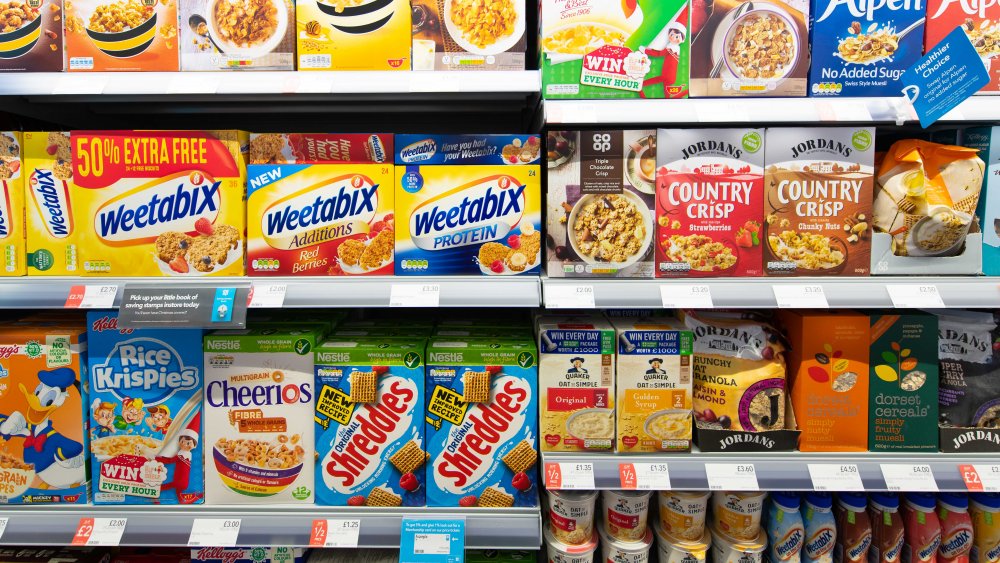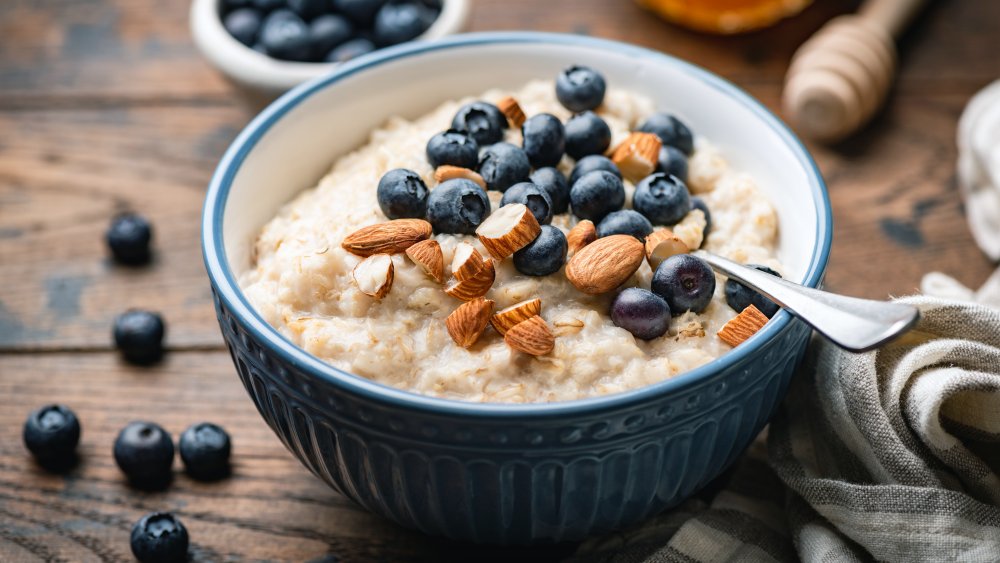When You Eat Cereal Every Day, This Is What Happens To Your Body
We know that cereal is a convenient meal and, as Frosted Flakes mascot Tony the Tiger would say, it tastes GREAT! Especially in the morning, when we're looking for a fast breakfast food. Cereal is also perfect to snack on, or can even be eaten as dinner on those nights when you just can't look at the oven without your eye twitching — but have you ever wondered how healthy it actually is to eat cereal every day? We all know the story of how this American creation came into existence, but as a brief refresher (per History), Dr. John Harvey Kellogg built a medical spa and resort called the Battle Creek Sanitarium. It is here that Dr. Kellogg came up with cereal. Ultimately in 1898, through trial and error, he stumbled upon what would become the recipe for Corn Flakes, and in 1906 cereal was born. Kellogg's expectation was this box of breakfast food would become a healthy option to consume in the morning.
Fast forward to the present, and it is estimated that 50 percent of Americans eat cereal as their first meal of the day, with each person eating anywhere from 101 to 160 bowls every year and over 2.7 billion boxes of the stuff sold annually (via South Florida Reporter). But how healthy is cereal really? And what happens when you eat cereal on a regular basis?
Cereal nutrition facts
First, it is important to remember that cereal is made from processed grains and flours, with sweeteners like sugar generally being the second or third ingredient listed on the box (via Healthline). In fact, per the South Florida Reporter, 816 million pounds of sugar are used every year by the cereal industry to make our favorite products. Eating breakfast cereals that are high in sugar can cause your blood sugar and insulin levels to sky rocket, followed by a crash within hours and that leaves your body wanting more. Consuming too much sugar can also lead to a number of diseases that include type 2 diabetes, heart disease, and cancer.
In fact, Thrillist writer Wil Fulton conducted an experiment where he ate only cereal for every meal for a full week. Fulton found that by eating a steady diet of some of our favorites — Froot Loops, Frankenberry, Cap'n Crunch, and Cinnamon Toast Crunch are all namechecked — his body experienced extreme highs and lows, and by just the third day he found himself craving fruits and vegetables. Jennifer Christman, a licensed dietitian, explained to the writer: "You are probably experiencing brain fog. Your blood sugar is spiking then dropping, you aren't getting the nutrients you need." She went on further to note that while cereals are fortified with lots of vitamins and minerals, they do not contain everything our bodies need to operate.
Cereal might cause portion control issues
While you may remember the Special K commercials that suggested if you ate their cereal you could lose weight, that might be difficult if you're not practicing portion control; and according to an experiment conducted by Consumer Reports, most of us aren't when it comes to cereal. Apparently, the majority of people are surprised by how small one serving is, and part of the confusion stems from the fact that the serving size for each cereal varies depending on how dense it is.
Consumer Reports compared a light cereal like Cheerios and a dense cereal like granola to highlight this point, noting that the serving size for a cereal like Cheerios is typically about 1 cup or 1 ounce in weight, versus a cereal like granola, which is more likely to have a serving size that is only a half a cup, but 2 ounces in weight. To further illustrate this issue, the publication asked consumers to pour their average cereal portion to test their serving size know-how. The experiment found that 92 percent of participants exceeded the recommended serving size, and the denser the cereal, the more people poured. While this overconsumption didn't increase the calories of the bowl of Cheerios that dramatically, it did make a significant impact with the granola. Translation: you might be eating way more calories, fat, and sodium in your bowl of cereal than you think. The publication suggests that cereal lovers use their favorite bowl and measure out a proper serving, so they know how much to pour in the mornings.
For a healthier breakfast, pick cereals that are rich in fiber and low in sugar
All that said, the world is still (for better or worse) hooked on cereal; and if you are going to eat this convenient breakfast food, Healthline notes that you want to be smart about how you choose which one you eat. They suggest you choose a cereal that is high in fiber, with at least 3 grams per serving being your target. According to Consumer Reports, Kellogg's All-Bran Original, Post Grape-Nuts The Original, Post Shredded Wheat Original Spoon Size, and Post Shredded Wheat Wheat 'n Bran Spoon Size are the top cereals when it comes to fiber — and they taste pretty good as well. Fiber-rich cereals will fill you up and help control your appetite, and are also known to help decrease the risk of type 2 diabetes. Per the University of California San Francisco Health, the daily recommended intake for fiber is 25 to 30 grams, but American adults generally only get about 15 grams from their food choices.
Healthline also cautions cereal eaters to not only practice portion control, but to also limit their sugary cereals, meaning perhaps those Reese's Puffs should be a sometimes cereal rather than a daily treat. Additionally, they recommend pairing your cereal with a good protein rich food like Greek yogurt to help you feel full and aid in suppressing those mid-morning munchies.



